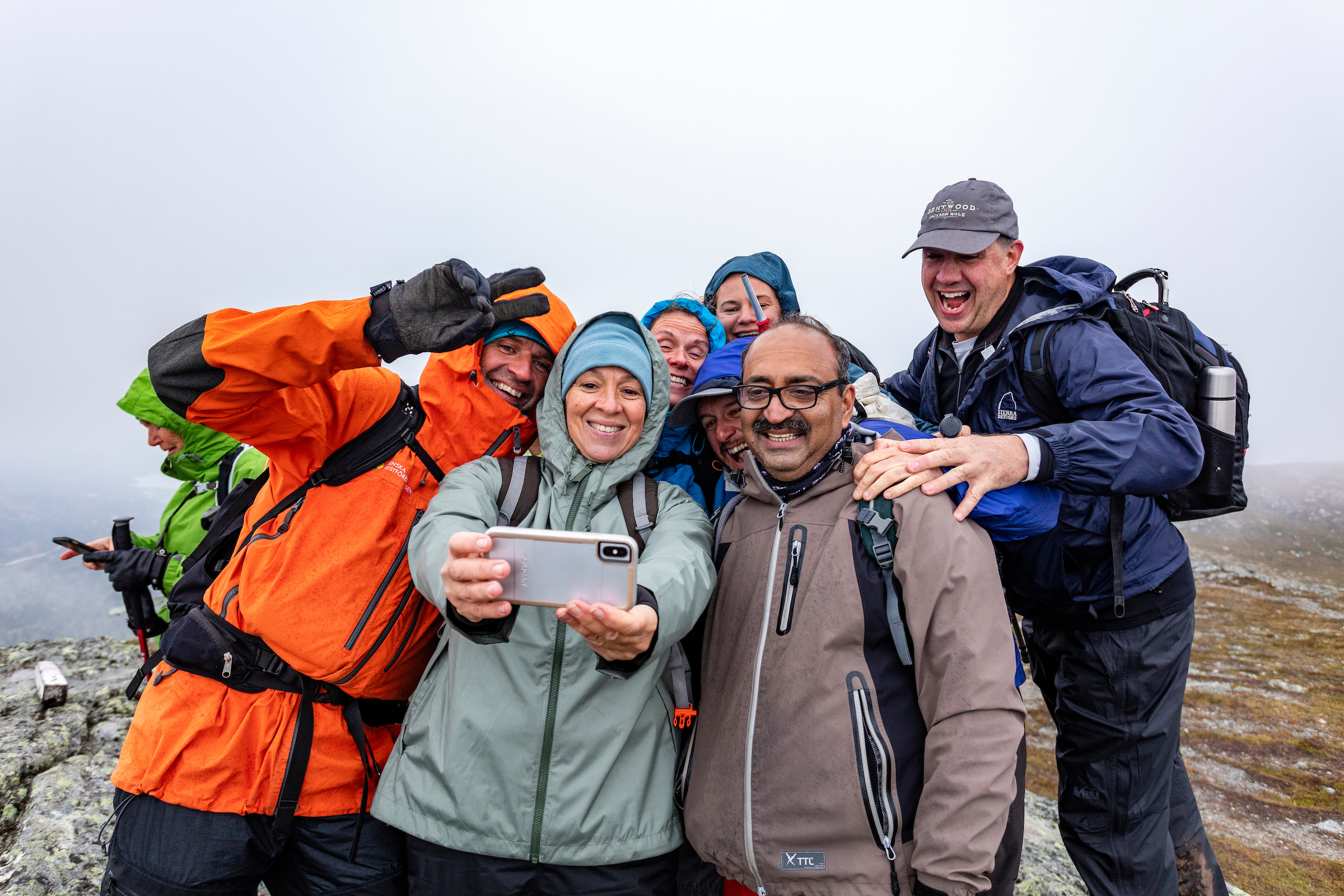Today, as they did thousands of years ago, the Sami people leave no footprint on the land in which they live.
Drastically changing landscapes accompany my six-hour train ride from Gothenburg to Mora as I stare out the window. From Mora, it is another three hours by bus to the Dalarna mountains. Sweden is a vast country, yet traveling north, I am still only on my way to the southernmost Sami people of the Nordics. At my final destination, the mountain station of Grövelsjön, the temperature has dropped by 12 degrees and the beautiful landscape is hiding behind a thick layer of fog.
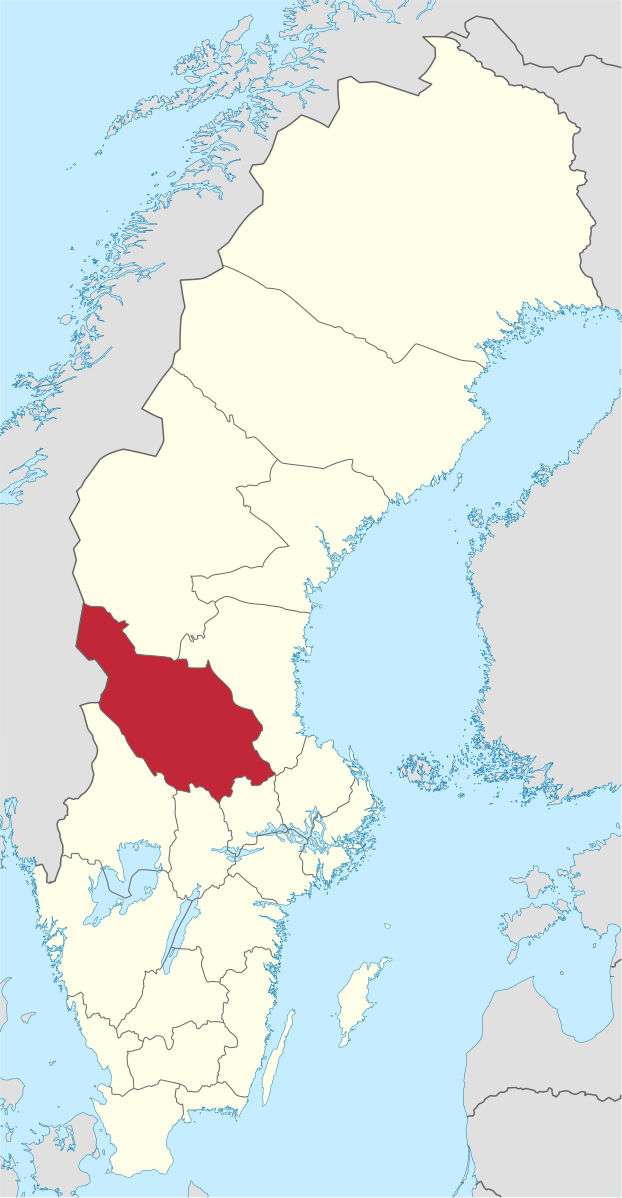
I am curious about what to expect, there are 800 members of the Adventure Travel Trade Association (ATTA) traveling to Sweden and participating in 23 different pre-adventures scattered over the country. This World Summit welcomes professionals from various fields within the adventure travel industry. Not the everyday tour group you might expect during an organized outdoor adventure.
The thirteen participants of our particular group come together from nine nations to experience Sami life. We are welcomed by Peter and Helena Andersson who owns the family-run business of Renbiten. Renbiten translates as "bitten by the reindeer“, as we all will be just hours from now. Ahead of us are three filled days, where we will experience Sami-life.
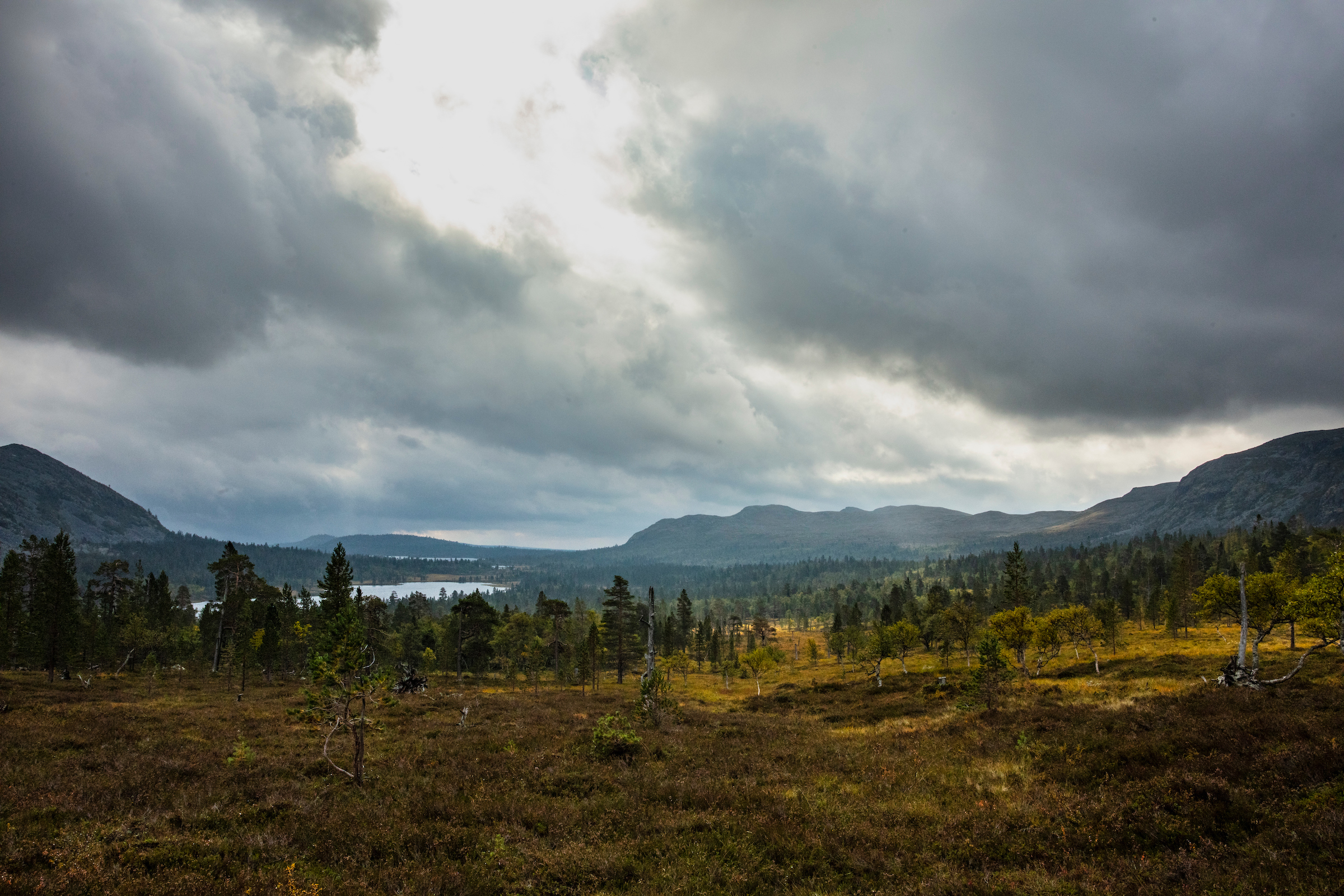
Laughing quickly becomes our common language.
Courtesy of our hosts, we are experiencing a rather rare state of complete harmony between Sami and Swedish culture - Helena is Swedish and Peter is Sami. As a multicultural group of thirteen, we are hitting it off straight away. Vishwas arrived from India, but his luggage was lost somewhere between Gothenburg and Oslo. Therefore, our first icebreaker is to dress him with all the spares we can find in our minimal outdoor-packs. For a patchwork outfit, Vishwas is looking like an experienced outdoor pro, with a hint of Indian colors. Helena and Peter greet us in such a friendly way, that at the dining table we all have the feeling like we have met them before. The conversation is going so well that our waiter politely reminds us to get the starters from the buffet, shyly adding that the main course has to be served before 11 pm. Today's serving: Arctic Charr. In an astonished tone, one of our American companions asks "This is Arctic shark?" "No, no... no sharks in Sapmi.“ Peter and Helena can hardly deliver their explanations between the laughter. The Arctic Charr is a local river salmon, known as a Swedish delicacy. Our first lesson of local knowledge has been shared, there were many more lessons to follow!
Laughing quickly becomes our common language to bridge our multicultural differences. We all came from far and wide, from the American West Coast to India, from Sapmi to Latin America.

The next morning, the thick layer of fog remains and we still only glimpse a limited view of the landscape - in stark contrast to the group's curiosity about Sapmi. After a gourmet breakfast, we drive the few kilometers over to Norway, where we will hike to the highest elevation of the region, the Båthusberget at 830 meters.
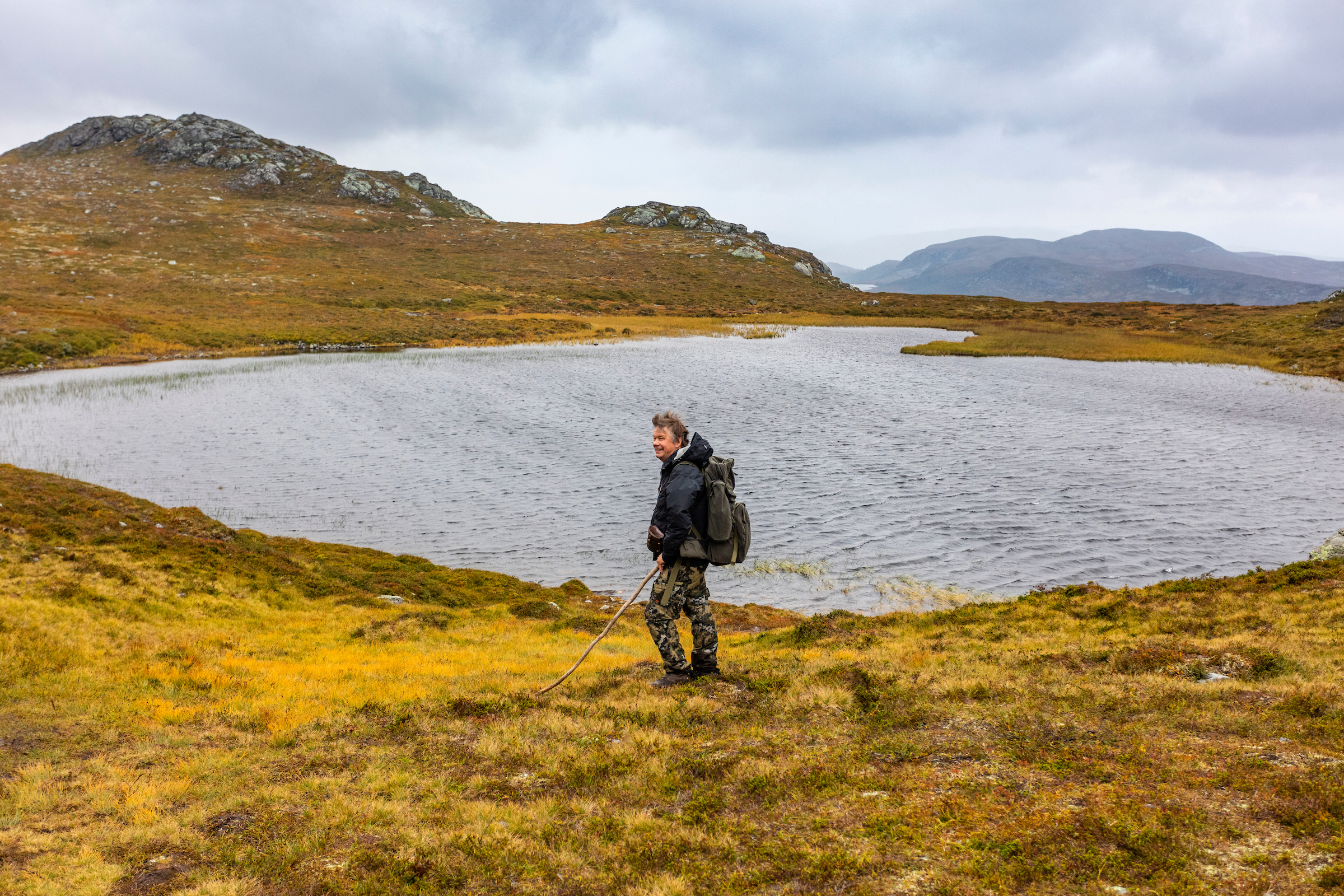
The rapid changes in weather, from the sun to horizontal rain thanks to strong winds, make our medium hike of only nine kilometers into a full-day tour. Of course, this wasn't helped by a group that was easily distracted. It's natural when you have a handful of photographers, filmmakers, and bloggers hiking together. It’s like kids on bicycles, every couple of minutes someone goes missing. At times a member of our party would be hanging rear-end up out of the bushes photographing shrubs of special interest, at other times, rear-end up because the swamps and rocks had caught us by surprise. Peter is clearly amused by all our collective activities, something that appears to be non-standard compared to the usual tours he guides. Generously he accommodates most of our activities and calmly oversees his flock from the back, making sure no one goes missing for good and collecting our dropped equipment. To him, this is a bit like reindeer herding, just vice-versa. With his reindeer, Peter takes the lead with one of the tamed reindeer accompanying him on a rope. Traveling from forest to forest that is full of lichen, the main source of food of the reindeer. Once the tamed reindeer follows, the whole flock tags along.
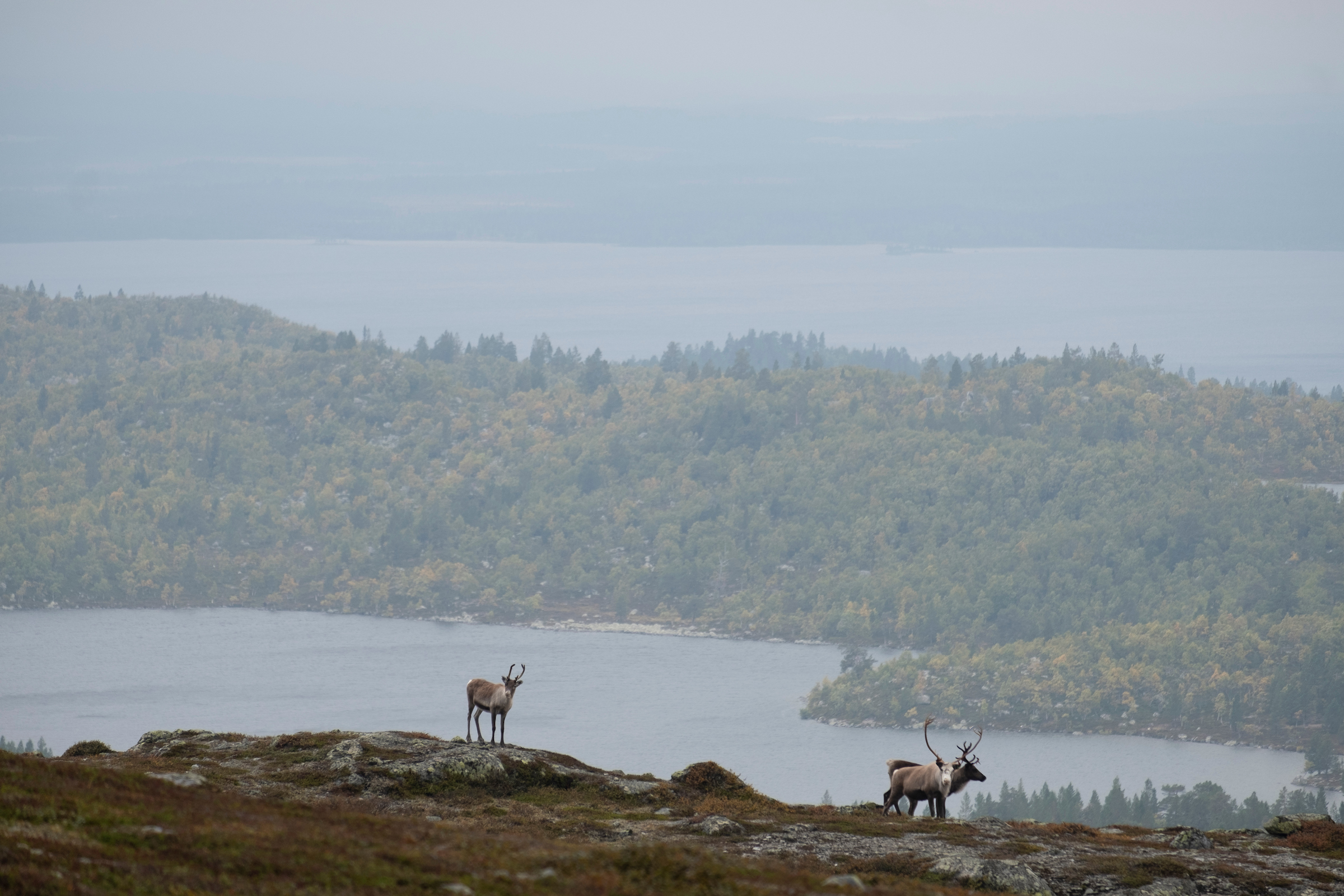
The autumn colors already plunge the landscape into bright reds and yellows, contrasted by the blue of the lakes and the last green of summer. Whist hiking around the mountain, we pass a couple of reindeer across the vast landscape. The reindeer know that their time has come to be herded together for the calf-marking - one of the key dates in the Sami-calendars, when the calves get their signature earmarking. Every Sami has its very own version, which is applied to the ear with a knife. This event also serves to determine which reindeer will be taken out of the flock to be slaughtered. It’s a traditional practice of the Sami circular economy - not one part of the slaughtered reindeer is wasted. Antlers and leather are reserved for the Duodji, the Sami name for the many handcrafted artworks, ranging from knife-handles to the solid-hue weavings, spun pewter and silver bracelets. The meat will supply the nutrients and vitamins needed to pass through the long, dark winters, while the bones are sold for dog food. Slight changes in the practice itself make it noticeable that we are now in the 21st century, but most traditions date back as long as the Sami culture and have been practiced and passed on over generations.

Families were torn apart.
It is a recent phenomenon that Sami culture is rising in public interest, but most people still don’t know who the Sami people are - the Indigenous inhabitants of the northern parts of Scandinavia, ranging well into Russia. As with most indigenous people, the Sami have suffered a very similar fate of oppression, segregation, and discrimination from the Swedish state.
Even in our tour group, there is little knowledge about the difficult history between Swedes and Sami people. Peter has grown used to walking this tightrope, and he must now manage a tourist enterprise on the grounds of educating people in the midst of this challenging cultural heritage. Seemingly with ease and a good portion of humor, he tackles the challenge.
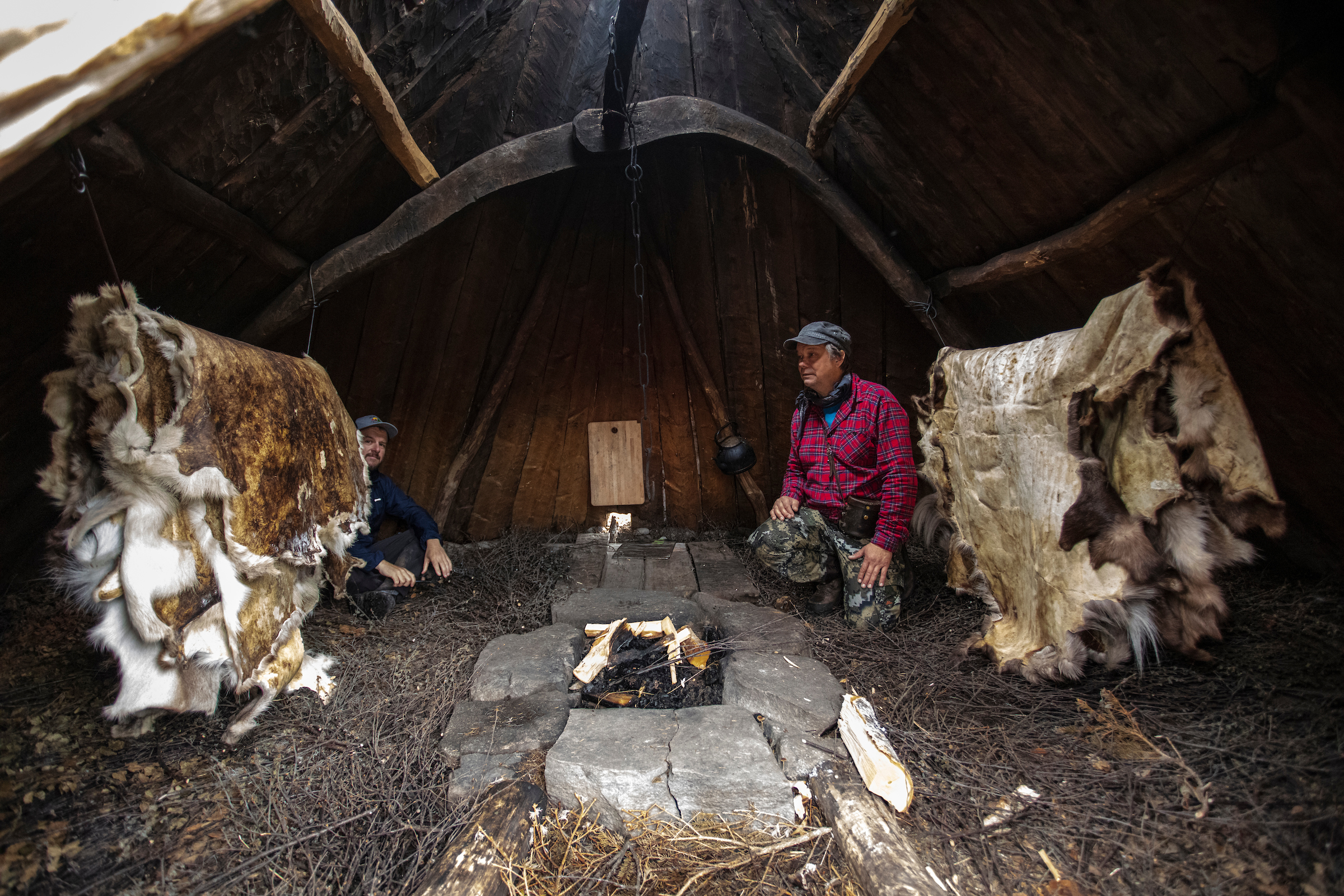
The last hundred years of Swedish-Sami history have not been marked by glorious deeds. At the beginning of the '80s, there were still special schools for the Sami children, as the State refused to let Sami children go to Swedish schools. Families were torn apart, children were sent to boarding schools hundreds of kilometers away from their families and were forced to speak Swedish, instead of Sami.
The attentive listener will hear the pain in Peter's gentle and calm voice when telling some of the stories from his own childhood. Along the way, he shows us the old tipi of his grandparents, which he and his siblings still partially grew up in. All stories and the remaining remnants of his heritage or culture come surrounded by unspoiled, pristine landscape.
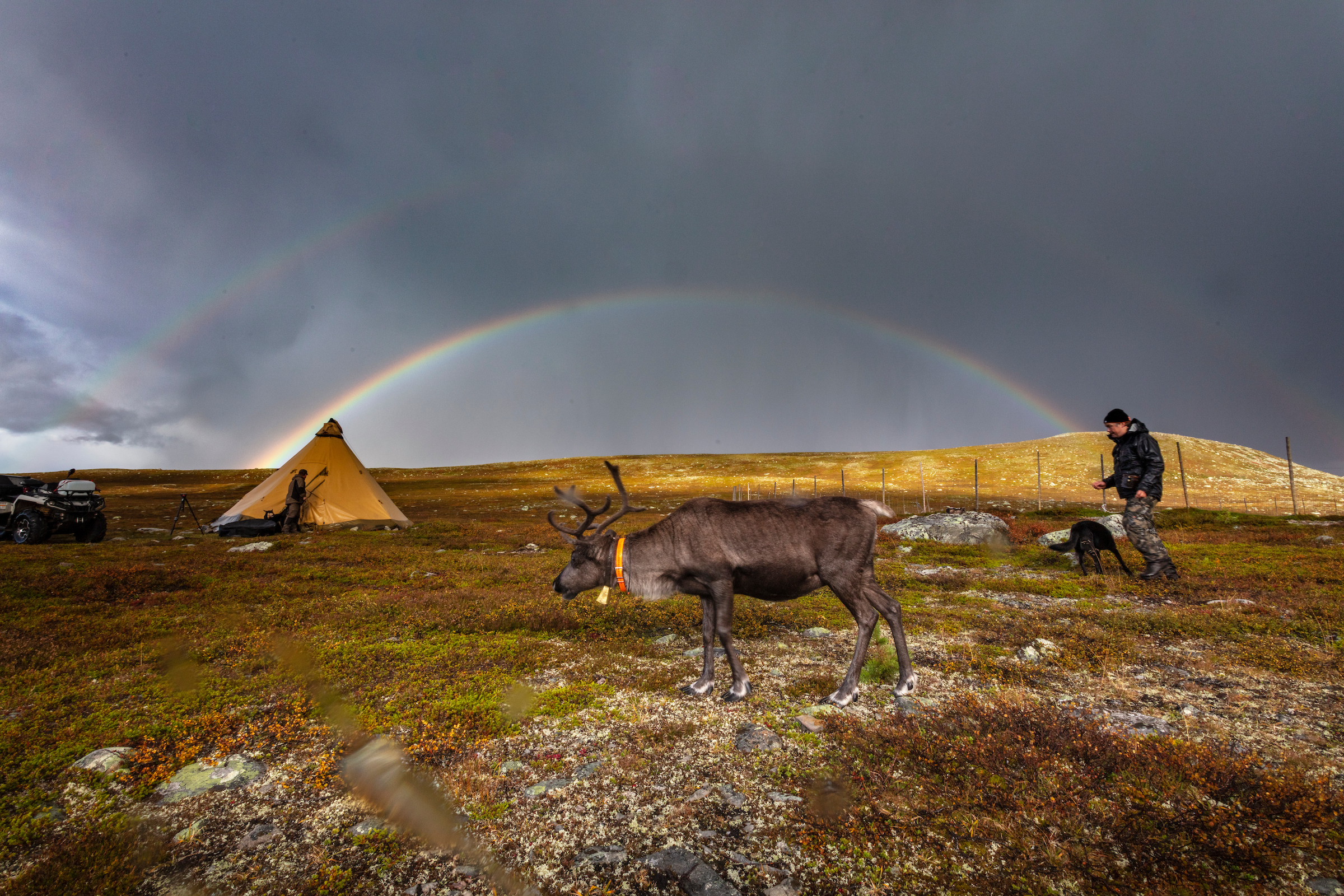
Whilst on the trek we were asked to consider what the very space we were walking on would look like if farmers had let their cows graze here? Importantly, there would not be any Letharia vulpina, the highly poisonous wolf's lichen. Historically used as lethal fox bait, it was a natural way to defend the reindeer against predators. This lichen has allowed the reindeer population to flourish.
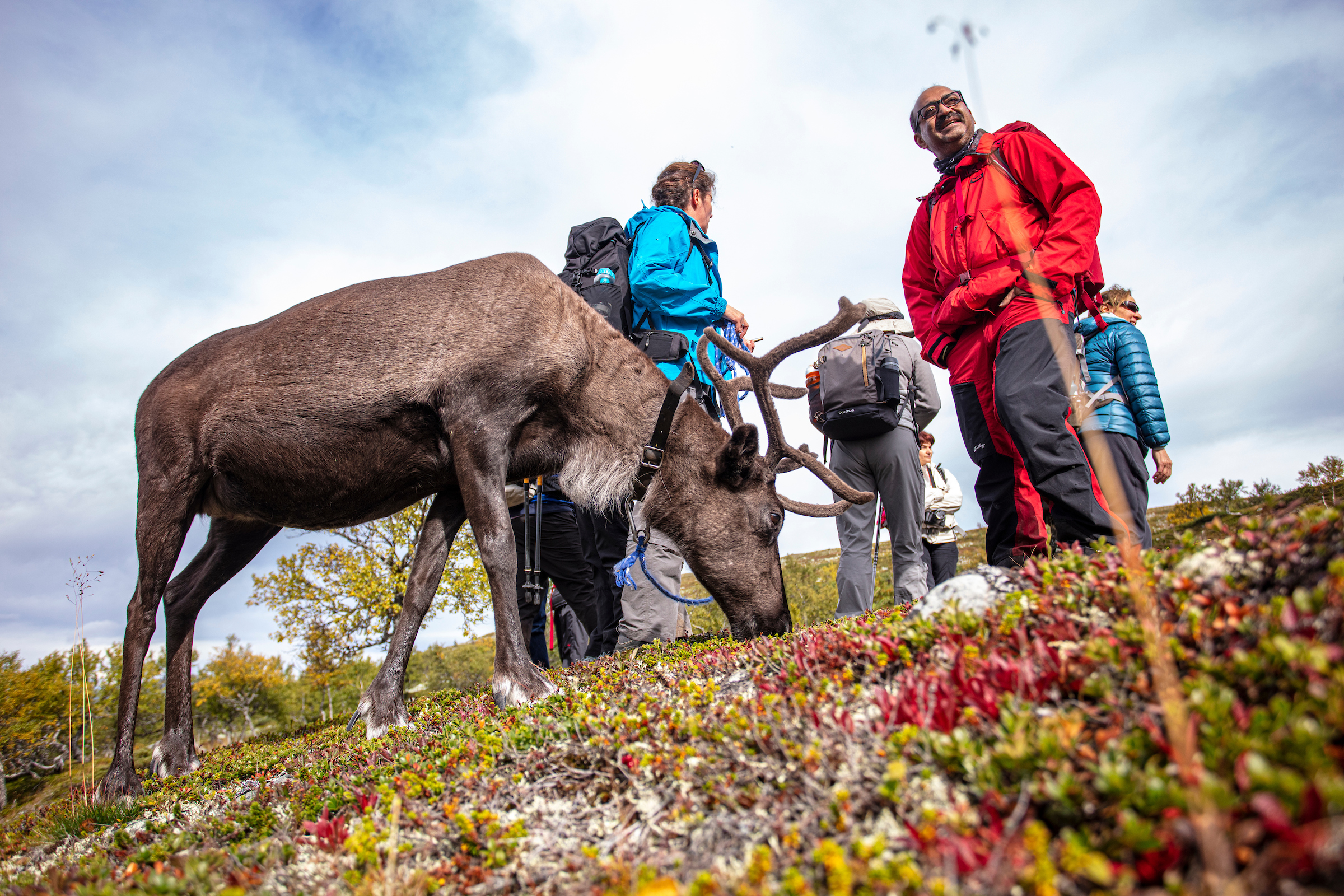
"Don't leave a footprint while going through life"
The occurrence of the wolves lichen is limited to the boreal-alpine area, mostly found in certain pines or larches. From biologist and specialist for boreal forests, Sebastian Kirppu, we learn that this lichen is an indication of a healthy ecosystem - a pristine old-growth forest, a rarity in Sweden nowadays. As is the same everywhere around the world, the fate of several species' survival is linked with one another. Lichen feeds the reindeer, reindeer are the subsistence of the Sami and all three inhabit the areas of boreal-alpine growth - an area that is increasingly threatened by a commercially driven logging industry.
[gallery type="rectangular" link="file" size="full" ids="14655,14650,14649,14646,14657,14669,14672,14653,14648"]
This is complex information entering our brains but it's temporarily stopped by laughter. The wind is carrying nothing but our gloomy silence across the plains, but now it is Peter's turn to lead us from the threatening ridge of cultural awakening and understanding back into more moderate terrain and he does so with great care.
Calm voiced but determined, he says "we are still here", these words aren’t his, they come from the famous Sami singer Sofia Jannok. The message is communal good. The Sami are strong and proud people. Stoically, they have endured the burden of cultural discrimination, but as long as there will be reindeer, there will be Sami. The Sapmi community carries each other and is carried by the paths of their reindeer, which do not stop, not even at national borders. For many of us who grew up with the norm of landowners, this is hard to understand. We have lost our connection to nature and the ability to live in it, in harmony, which means to move on when resources demand. Underlining this is the message Peter is carrying within him: "Don't leave a footprint while going through life". Printed, those lines read almost platonic, but out here in the midst of wilderness... I clearly grasp the meaning of the message!
Meanwhile, the raindrops are now hitting us in the face as we continue walking. The pace is slow but consistent, one step after the next, just like the Sami have trekked for decades. To escape this inhospitable storm, we all follow the same path, step by step. Slowly, the sky clears up and the sound of laughter again reaches my ears, I think it came from Peter this time...
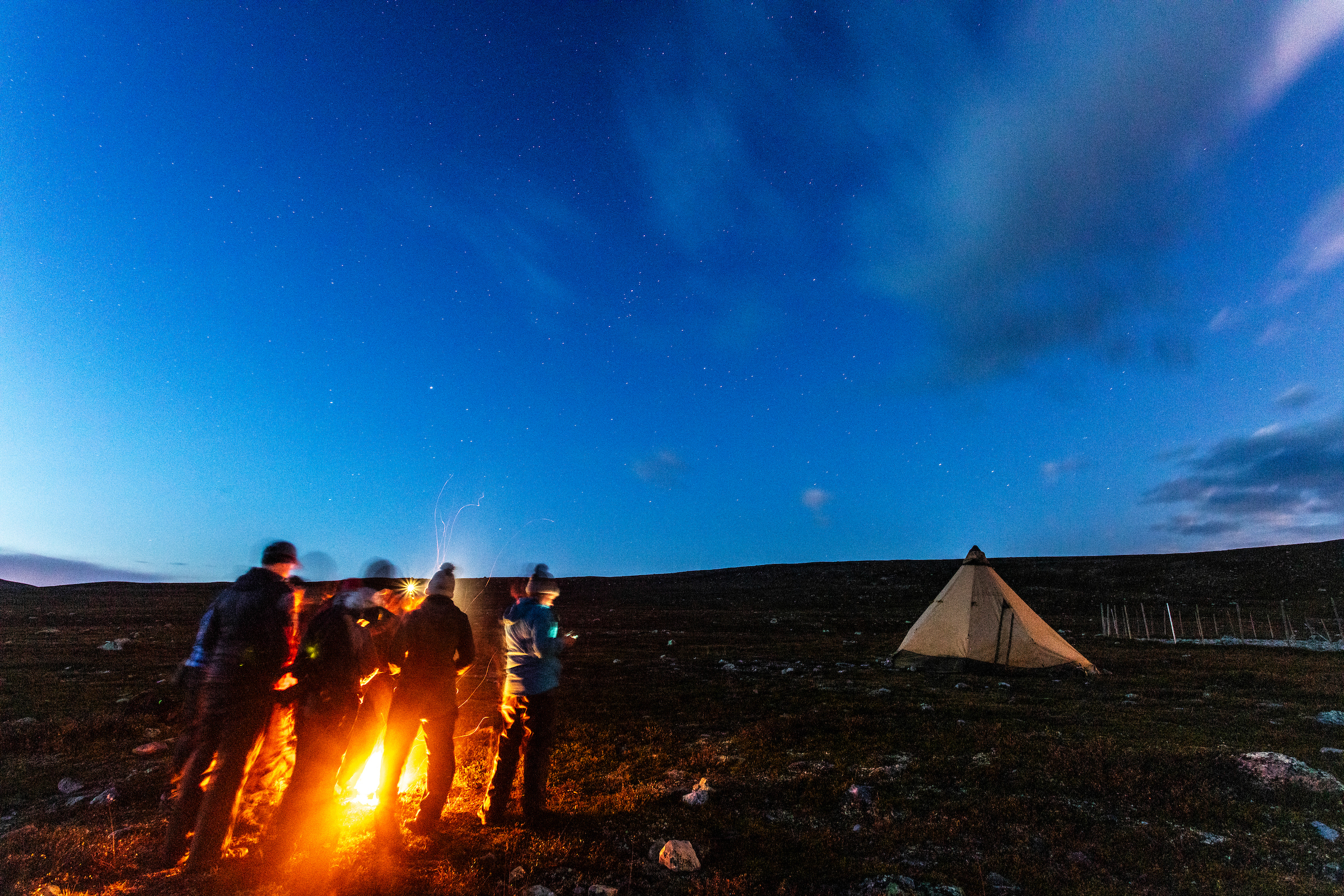
The next night we immerse ourselves in another Sami practice, some more successfully than others, by rounding up, or attempting to round up reindeer. Being up here on Sami grounds, surrounded by three tipis, our conversations again circle back to those dark times of Swedish history. As the temperature drops significantly, we hurdle around the campfire. With the rising full moon, the campfire-blues rise in us and Archana from India asks Peter to sing something traditional for us. Peter chooses to Joik. A Joik is a connection between the physical and metaphysical world by the sound of the human voice. It is used to express feelings or the elements of wind and water or activities such as herding reindeer or describing the struggle of survival in the vastness of the Nordic wilderness. But it can also express the collective pain of a Nation, like Sapmi.

We don’t sleep much this night, on one hand, because we are not used to lying on a reindeer skin on the ground in a tipi, and secondly because our minds are busy digesting the metaphysical experience of tonight.
Slowly I come to understand that tourism has become an important tool for indigenous people to communicate about everything that they have endured, to use it as a way to overcome political and social injustice. What Peter and Helena have done with us is not only to offer a wonderfully guided time in a very precious part of Sweden's nature, but they have step by step made us ambassadors for humanity, specifically ambassadors who have found enlightenment for the preservation of nature, wildlife, our planet, and indigenous cultures by learning about Sapmi.
We all choose Renbiten for an adventure, what we got is an experience that shaped us for a lifetime!
